- Open Access
- Article
Cost & Efficiency analysis of Battery & SC based Hybrid Energy Storage system for Solar OFF Grid applications
Lead Engineer, Transmission Operation and Maintenance, TATA Power Company Limited, Mumbai, 400066, India
* Author to whom correspondence should be addressed.
Journal of Engineering Research and Sciences, Volume 4, Issue 4, Page # 1-7, 2025; DOI: 10.55708/js0404001
Keywords: Battery, Microgrid, Super capacitor, Hybrid Energy Storage system
Received: 05 February 2025, Revised: 02 April 2025, Accepted: 03 April 2025, Published Online: 27 April 2025
(This article belongs to the Section Engineering and Technology: Electrical Engineering (ELE))
APA Style
Kotana, R. (2025). Cost & efficiency analysis of battery & SC based hybrid energy storage system for solar OFF grid applications. Journal of Engineering Research and Sciences, 4(4), 1–7. https://doi.org/10.55708/js0404001
Chicago/Turabian Style
Kotana, R. 2025. “Cost & Efficiency Analysis of Battery & SC Based Hybrid Energy Storage System for Solar OFF Grid Applications.” Journal of Engineering Research and Sciences 4 (4): 1–7. https://doi.org/10.55708/js0404001.
IEEE Style
R. Kotana, “Cost & efficiency analysis of battery & SC based hybrid energy storage system for solar OFF grid applications,” J. Eng. Res. Sci., vol. 4, no. 4, pp. 1–7, 2025, doi: 10.55708/js0404001.
This study evaluates the feasibility, efficiency, and cost-effectiveness of a Hybrid Energy Storage System (HESS) for a 30KW Microgrid. The research analyses various storage configurations incorporating batteries and supercapacitors, considering factors such as cost, reliability, and performance. While conventional Battery Energy Storage Systems (BESS) offer lower initial costs, they suffer from long-term reliability issues due to frequent replacements. In contrast, a HESS configuration, where supercapacitors handle transient changes and batteries manage low-frequency variations, enhances system stability, extends battery life, and improves overall efficiency. The study reveals that supercapacitors should have a greater share in storage systems where transient disturbances are frequent, while stable environments can rely more on batteries to optimize costs. Despite a higher initial cost, HESS proves to be more cost-effective in the long run by reducing battery degradation and replacement expenses. Additionally, the integration of supercapacitors improves efficiency and system resilience by quickly responding to disturbances, ensuring uninterrupted operation. A closed-loop control strategy, incorporating a low-pass filter, effectively manages power distribution between supercapacitors and batteries, minimizing energy losses and enhancing load response. The findings indicate that HESS presents a sustainable and reliable solution for microgrids, especially in off-grid and renewable energy-based applications.
1. Introduction
Energy plays a crucial role in industrialized societies and economic development. It is an essential factor in daily life, and effective energy management is critical for future economic prosperity. Historically, fossil fuels have been the primary sources of energy generation, as most power infrastructure relies on coal, oil, and gas. However, these sources are not environmentally friendly and are finite. Their depletion will contribute to pollution and global warming. Additionally, energy accessibility remains a challenge in many regions. Approximately 1.2 billion people globally lack access to electricity, including over 635 million in Africa and 237 million in India alone [1]. The high costs of energy production and the distance between power generation and distribution centres are key factors behind this issue. To address these challenges, the transition to renewable energy sources such as solar, wind, hydroelectric, and geothermal power is necessary. Among these, solar energy and hydrogen fuel cells stand out due to their efficiency, reliability, environmental benefits, and high-power density [2]. Solar energy is particularly advantageous as it generates electricity without harmful by-products. Given the need for sustainable energy solutions, microgrid systems are emerging as a viable option. Although AC power transmission is standard, most household appliances—including mobile chargers, laptop adapters, and televisions—internally operate on DC [3]. Studies indicate that many household appliances can function on DC with minimal or no modifications [4–7]. A DC distribution system offers higher efficiency and improved power quality. Devices such as LED lights, laptop chargers, mobile chargers, and domestic fans operate more efficiently on DC than on AC. DC microgrids are gaining popularity in modern electric grids as they facilitate the seamless integration of renewable energy sources (RES), energy storage systems (ESS), and electric loads [8]. Solar power is one of the most cost-effective, sustainable, and environmentally friendly renewable energy sources. Typically, solar power is stored in an energy storage system before being utilized. Among various ESS technologies, batteries are the most common. However, their low power density results in slower charge and discharge cycles [9]. In recent years, supercapacitors (SCs) have emerged as an alternative energy storage solution. SCs provide high power density and respond rapidly to power fluctuations, enhancing system stability [10]. The combination of batteries and supercapacitors, known as a hybrid energy storage system (HESS), enhances overall system performance and extends battery life [11-12]. Several DC microgrid systems have been explored in the literature [13-16]. In [13-17], the authors proposed a DC microgrid system powered solely by solar PV, which connects multiple DC loads through point-on-load converters. However, this system lacks energy storage. [18] developed a solar microgrid with a 24V battery storage system, tested with LED loads. In [19] investigated solar microgrid solutions for Indian homes, proposing different configurations, including a rooftop solar-powered DC microgrid, a solar-AC system with an inverter for AC homes, and a solar-AC system with an inverter-less setup for DC homes. In [20], the authors designed a system incorporating solar PV as a source with battery storage.
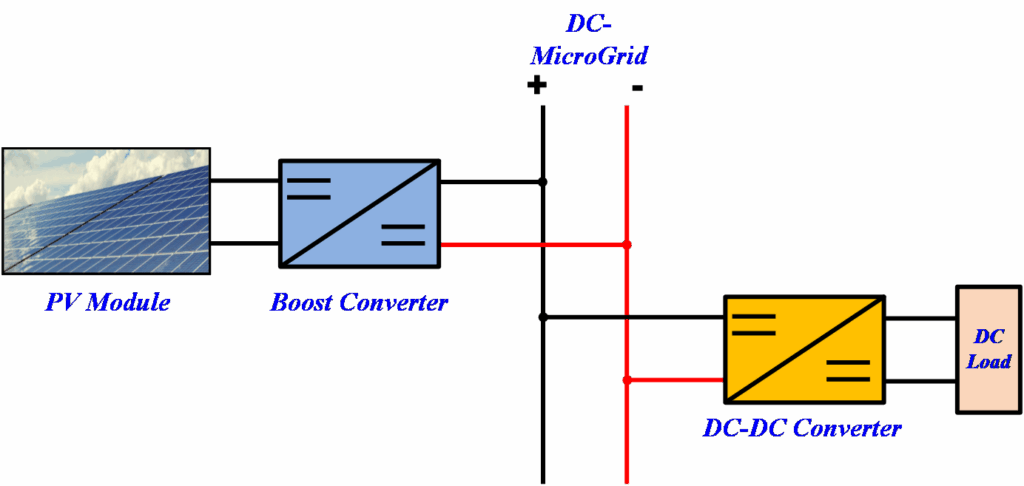
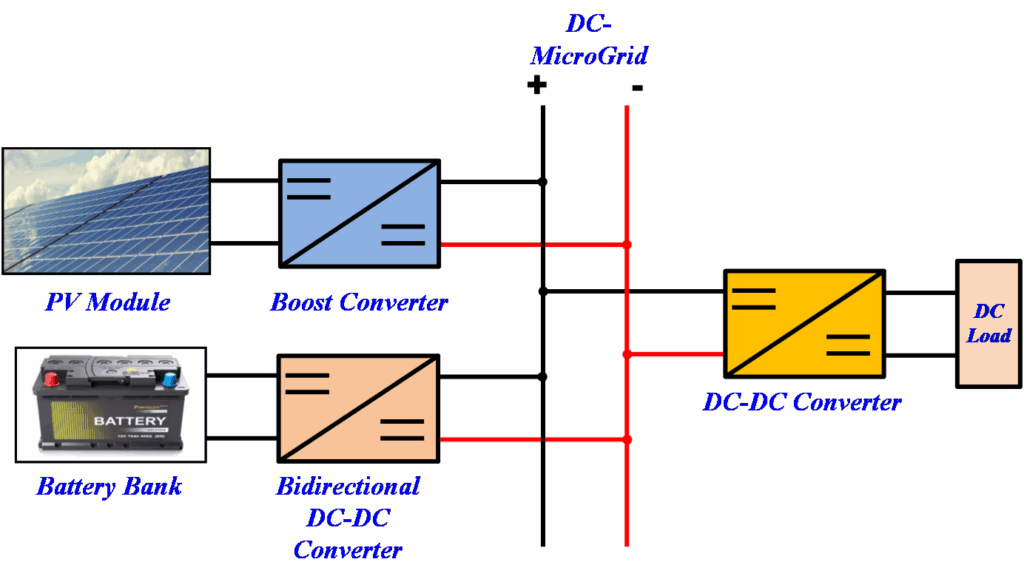
In the Authors suggest [21] analysed the power electronics requirements for operating kitchen appliances on both DC and AC. Their findings suggest that most appliances designed to accept a wide voltage range can function directly on DC. By eliminating the AC-DC conversion step, efficiency can be improved in DC-powered systems. A microgrid system integrating solar PV as a power source with a hybrid storage system consisting of batteries and supercapacitors has been explored in various studies [22-23]. Several works in the literature have discussed microgrids and their storage techniques, with the most conventional and widely used method being the Battery Energy Storage System (BESS). This study aims to conduct a cost analysis and comparison between BESS and the hybrid energy storage system (HESS), which combines batteries and supercapacitors for improved performance and efficiency.
2. Battery & Supercapacitor based Hybrid Storage system configuration.
Hybrid energy storage with a combination of battery and supercapacitor has been gaining a lot of interest lately. There have been developments in the area of research for different applications but mainly concentrating on off-grid solar applications. To develop a hybrid energy storage system (HESS) project, Duke Energy has partnered with Aquion Energy, Maxwell Technologies, and other parties. When solar power is on and the grid varies due to cloud cover or other weather conditions, the hybrid system makes advantage of Maxwell’s supercapacitors to help control solar smoothing events in real-time. The solar load is shifted with the help of the Aquion batteries to a period when the utility is more benefitted. It was implemented for a 1MW peak load. The hybrid energy storage system integrates patented energy management algorithms. While the battery bank provides long-duration power, the ultracapacitors handle short, intermittent duties. For example, when a cloud passes in front of the PV array, the ultracapacitors can quickly stabilize the power. When supply exceeds demand briefly, the ultracapacitor will absorb the additional energy [24-25].
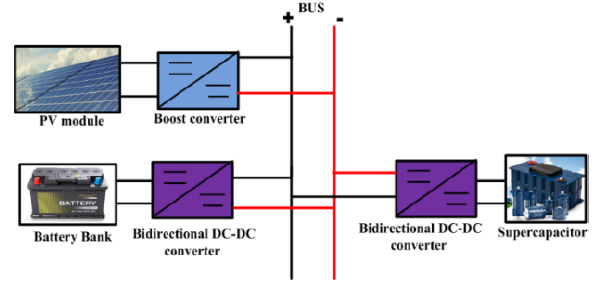
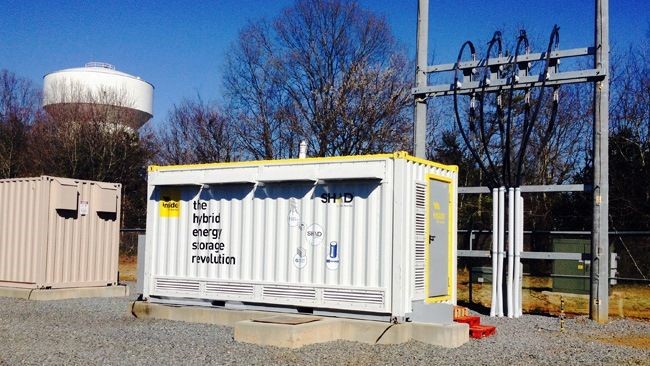
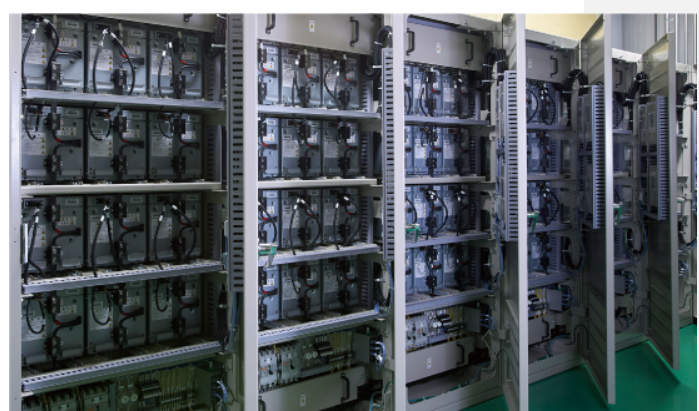

The development of hybrid battery energy storage technologies has been a focus for Hitachi Ltd. By combining lead-acid batteries, which offer great capacity, safety, and affordability, with lithium-ion capacitors, which have the power to react quickly to fluctuations with fast charge-discharge cycles, the company has created a hybrid battery energy storage system. Together with Shin-Kobe Electric Machinery Co. Ltd., the company has co-developed a 1.5 MW hybrid battery energy storage system. Hitachi has been implementing a hybrid battery energy storage system demonstration project on Izu Oshima Island, south of Tokyo, in collaboration with TEPCO* Power Grid, Inc. Because of its autonomous electrical grid, this island was chosen. The project has been supported by NEDO (The New Energy and Industrial Technology Development Organization).
There have been developments in battery-supercapacitor storage systems for Electric vehicle applications as well. The Tata Hybrid Magic car [26], created by the Automotive Research Association of India (ARAI) and Indian Space Research Organization (ISRO), includes a novel hybrid energy storage system that combines a normal battery pack with supercapacitors provided by ISRO. At Auto Expo 2020, it was on display on the Tata Ace platform. When fully charged, the Tata Magic hybrid prototype can travel between 120 and 150 km. This is because 40% of the vehicle’s energy needs are met by the smaller supercapacitor. As a result, there is a decrease in weight and expense and an increase in battery life. IIT Jammu & the Queensland University of Technology have developed a hybrid supercapacitor storage system for Electric vehicles.
3. Cost Analysis
Energy Density: In comparison to supercapacitors, battery storage has a higher energy density, which allows it to store more energy per unit of volume or weight. Supercapacitors and batteries with high energy densities are combined in hybrid storage.
Power Density: Compared to batteries, supercapacitors have a higher power density, which allows them to release and absorb energy more quickly. While batteries provide a steady energy supply, hybrid storage systems make use of the high-power density of supercapacitors to handle peak power demand.
Efficiency: While batteries lose some energy throughout the charging and discharging cycles, supercapacitors are more efficient in these operations. The application and design specifics have an impact on a hybrid system’s overall efficiency.
Cost: Although supercapacitors are typically more expensive than batteries, hybrid storage systems can offer cost-effective solutions by fusing the two technologies for maximum efficiency.
Lifespan: Compared to batteries, supercapacitors can withstand more charging cycles and have a longer lifespan. Hybrid storage solutions, on the other hand, can increase the battery life by lowering the quantity of charge-discharge cycles needed.
Considering the 30 KW Micro Grid system (i.e peak load of 30 KW) and considering the backup time to be provided by the storage system to be 14 Hrs.
Therefore, the total energy requirement on the storage system is 420 KWH, considering the worst-case scenario. The production by solar PV heavily depends on the temperature and location of the installation as the level of irradiation varies with location. Fig 6 shows the solar.
Irradiation variation throughout a day at one on TATA Power co Ltd’s Solar site. Hence design of the hybrid storage system depends on the multiple factors like the application, stability, temperature, and location. Where there are more chances of disturbances/ transient changes to the system, A configuration where supercapacitor contributing to the most of KWH requirement must be chosen since supercapacitor can respond quickly to changes as it releases large amount of energy in a short time. Similarly, the system where there are less chances of transient disturbances, a configuration with less contribution from supercapacitor can be chosen.
However, choosing either only supercapacitor or only battery storage systems have their own disadvantages. i.e., Using only supercapacitor for delivering the complete requirement will be very costly and not ideal. Similarly, using only battery storage implies that the system now cannot respond to any disturbances. It can be observed from the Table.2 that the cost of the storage system is the least when only battery storage is used & the cost is highest if only supercapacitor is used. This implies that both battery & supercapacitors if used alone, have their disadvantages & advantages. To address their disadvantages by merging their advantages, HESS can be a right choice by choosing the correct configuration depending on the application.
Table 1: Characteristics of Li-ion Battery and Supercapacitors [27-33]
Characteristics | Super Capacitors | Li-ion Battery |
Specified energy density (Wh/ kg) | 1-10 | 150-200 |
Specified power density (W/ kg) | <10000 | <2000 |
Charging duration | 0.3 to 30s | 0.5 to 3h |
Discharging Duration | 0.3 to 30s | 0.5 to 3h |
Life cycles | < 50000 | 5000 |
Operating Temperature(◦C) | -45 to 85 | -30 to 60 |
Eco-Friendliness | Moderate | Low |
Cost per KWH (in Rs) | 31000 | 17000 |
Efficiency | 95% | 85-95 % |
Table 2: Cost comparison for different configurations of storage systems.
Storage configuration | Cost (Lakhs) | KWH by Battery | KWH by Supercapacitor |
Only Battery | 71.4 | 420 | 0 |
Only Supercapacitor | 130.2 | 0 | 420 |
BAT:80% & SC:20% | 83.16 | 336 | 84 |
BAT:70% & SC:30% | 89.04 | 294 | 126 |
BAT:60% & SC:40% | 94.92 | 252 | 168 |
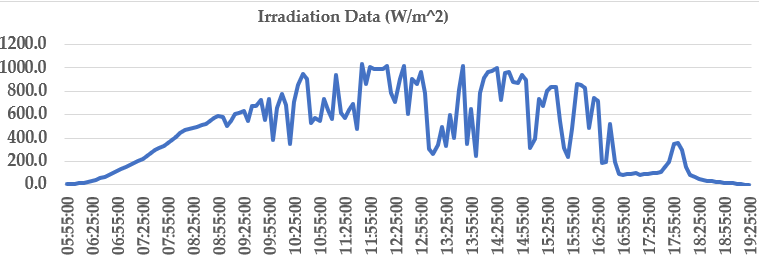
The primary source PV in the proposed system is not always reliable because power output is affected by a variety of parameters such as temperature, time, season, and other unknowns. Power management between battery and supercapacitor are controlled through a closed loop control in such a way that the supercapacitor reacts to transient, fast changes while the battery reacts to low frequency changes. The HESS control loop is depicted in Figure 7.

As it can be observed, total current is fed into a Low-pass filter and the high frequency part was given to the supercapacitor and the low frequency part to the battery.
The following analysis is done for a 30KW Microgrid for a configuration where battery is contributing to the 60% & supercapacitor is contributing to 40 % of the total energy requirement respectively. The following analysis was done considering the peak load requirement. Whereas, practically, the energy requirement will always be less than 420 KWH. With the help of the Table.1, the cost per KWH of battery and supercapacitor are calculated for different cases.
Figure 8 depicts the initial cost of battery storage & Hybrid storage system. It implies that the hybrid storage system has 32 % more initial cost than the conventional battery systems. However, in a long run, the Hybrid storage system has various advantages over the battery storage system in terms of cost.
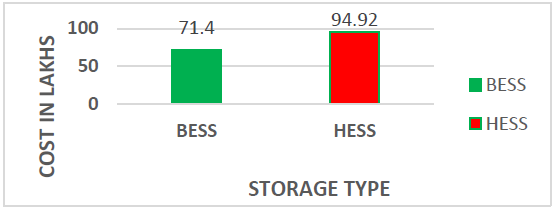
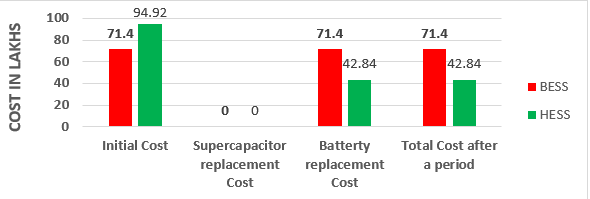
It is clear that the initial cost of the battery storage system is less than the hybrid storage system. In the BESS, there is no supercapacitor cost and hence the total cost will be for the battery set/pack. But in HESS, there is inclusion of supercapacitor along with the battery.
Therefore, in hybrid storage, there will be cost towards the supercapacitor as well because now the energy is shared between the battery and supercapacitor. As the batteries have limited life cycles, they need to be replaced after certain period. For a BESS, the whole battery set needs to be replaced after a certain time making the replacement cost same as the initial cost. But in HESS, the replacement cost would be less because the energy contributed by the battery is less as compared to BESS thus resulting in the low replacement cost after a period. It is also important to notice that with the supercapacitor responding to the transient changes in the system, the stress on the battery is reduced thereby reducing the number of cycles, hence increasing the life of the battery i.e., the replacement period in HESS will be slightly more than the conventional BESS.
Figure 10. Summarizes the cost & efficiency analysis between BESS & HESS.

4. Conclusion
This study analysed the feasibility and efficiency of a Hybrid Energy Storage System (HESS) for a 30KW Microgrid with a backup time of 14 hours, requiring a total storage capacity of 420 KWH. The analysis considered various factors such as cost, performance, and reliability of different storage configurations involving batteries and supercapacitors. The study demonstrated that while battery storage alone presents a lower initial cost, it suffers from long-term reliability concerns due to frequent replacements. On the other hand, HESS configuration, where the supercapacitor contributes to transient changes and the battery addresses low-frequency variations, enhances the overall system stability and extends battery life by reducing stress cycles. The findings suggest that in scenarios with high transient disturbances, supercapacitors should have a greater share in the storage mix to enhance system responsiveness. Conversely, in relatively stable environments, the reliance on supercapacitors can be reduced to optimize costs. The cost analysis revealed that although HESS has a 32% higher initial investment than a traditional Battery Energy Storage System (BESS), it offers long-term economic advantages by reducing battery replacement costs and improving overall efficiency. Even though the work has mainly focussed on the cost perspective, the added advantage will be because of higher efficiency as well. Since the supercapacitor is having a higher efficiency than the battery, the efficiency of the combined system will be higher than the battery storage & less than the supercapacitor storage system. Another main added advantage is of the stability. With supercapacitor added in the system, if there are any transients/ disturbances during the day also, the supercapacitor will respond quickly to nullify the effect and will not allow the shutdown of the system thereby increasing the reliability of the complete system. Furthermore, the study highlights that HESS effectively mitigates the limitations of both battery and supercapacitor storage by leveraging their respective strengths. The implementation of a closed-loop control system, which intelligently distributes energy between the supercapacitor and battery using a low-pass filter, ensures optimal power management. This approach minimizes energy losses, enhances response time to load variations, and extends the operational lifespan of the storage components. In conclusion, the adoption of an appropriately configured HESS can provide a cost-effective and sustainable solution for microgrid applications. Future work may focus on optimizing control algorithms and exploring alternative energy storage technologies to further enhance system efficiency and cost-effectiveness. The integration of renewable energy sources with an advanced HESS can significantly improve the reliability and sustainability of microgrids, making them a viable solution for remote and energy-sensitive locations
Conflict of Interest
The authors declare no conflict of interest.
- Sieminski, A. Annual Energy Outlook 2015; US Energy Information Administration: Washington, DC, USA,2015.
- A. K. Podder, K. Ahmed, N. K. Roy, and P.C. Biswas, “Design andsimulation of an independent solar home system with battery backup,”Proc. in IEEE 4th ICAEE, Dhaka Bangladesh, 28-30 September, 2017, pp.427-431.
- A. F. B. Santos, G. P. Duggan, C. D. Lute and D. J. Zimmerle, “An Efficiency Comparison Study for Small Appliances Operating in DC and AC in Minigrids,” 2018 IEEE Global Humanitarian Technology Conference (GHTC), 2018, pp. 1-2, doi: 10.1109/GHTC.2018.8601861
- P. van Duijsen, J. Woudstra and D. Zuidervliet, “Requirements on Power Electronics for converting Kitchen Appliances from AC to DC,” 2019 International Conference on the Domestic Use of Energy (DUE), 2019, pp. 190-197.
- K. Techakittiroj and V. Wongpaibool, “Co-existance between AC-Distribution and DC-Distribution: In the View of Appliances,” 2009 Second International Conference on Computer and Electrical Engineering, Dubai, United Arab Emirates, 2009, pp. 421-425, doi: 10.1109/ICCEE.2009.85.
- M. A. Rodriguez-Otero and E. O’Neill-Carrillo, “Efficient Home Appliances for a Future DC Residence,” 2008 IEEE Energy 2030 Conference, 2008, pp. 1-6, doi: 10.1109/ENERGY.2008.4781006.
- B. Hredzak, V. G. Agelidis and M. Jang, “A Model Predictive Control System for a Hybrid Battery-Ultracapacitor Power Source,” in IEEE Transactions on Power Electronics, vol. 29, no. 3, pp. 1469-1479, March 2014, doi: 10.1109/TPEL.2013.2262003
- M. E. Glavin, P. K. W. Chan, S. Armstrong and W. G. Hurley, “A stand-alone photovoltaic supercapacitor battery hybrid energy storage system,” 2008 13th International Power Electronics and Motion Control Conference, Poznan, Poland, 2008, pp. 1688-1695, doi: 10.1109/EPEPEMC.2008.4635510.
- Hamzeh M, Ghazanfari A, Mohamed YAI, Karimi Y. Modeling and Design of an Oscillatory Current-Sharing Control Strategy in DC microgrids. IEEE Trans Ind Electron. 2015;62(11):6647-6657. https://doi.org/10.1109/TIE.2015.2435703.
- Glavin, M.E. & Chan, Paul & Armstrong, Sara & Hurley, W.G.. (2008). A Stand-alone Photovoltaic Supercapacitor Battery Hybrid Energy Storage System. 2008 13th International Power Electronics and Motion Control Conference, EPE-PEMC 2008. 1688 – 1695. Doi: 10.1109/EPEPEMC.2008.4635510.
- Choi, Mid-Eum & Kim, Seong-Woo & Seo, Seung-Woo. (2012). Energy Management Optimization in a Battery/Supercapacitor Hybrid Energy Storage System. IEEE Trans. Smart Grid. 3. 463-472. doi: 10.1109/TSG.2011.2164816.
- Arunkumar G, Elangovan D, Sanjeevikumar P, Nielsen JBH, Leonowicz Z, Joseph PK. DC Grid for Domestic Electrification. Energies. 2019; 12(11):2157. https://doi.org/10.3390/en12112157
- Mehmood, N. Ashraf, L. Alvarez, T. N. Malik, H. K. Qureshi, and T. Kamal, “Grid integrated photovoltaic system with fuzzy based maximum power point tracking control along with harmonic elimination,” Trans. Emerg. Telecommun. Technol., vol. 33, no. 2, p. e3856, 2022, doi: 10.1002/ett.3856.
- Z. Hassan, H. Li, T. Kamal, M. Nadarajah and F. Mehmood, “Fuzzy embedded MPPT modeling and control of PV system in a hybrid power system,” 2016 International Conference on Emerging Technologies (ICET), Islamabad, Pakistan, 2016, pp. 1-6, doi: 10.1109/ICET.2016.7813236.
- Z. Hassan, H. Li, T. Kamal, M. J. E. Trujillo, and B. Cevher, “Load sharing and arrangement through an effective utilization of SOFC/Super-capacitor/Battery in a hybrid power system,” Iran. J. Sci. Technol. Trans. Electr. Eng., vol. 43, no. 2, pp. 383–396, Jun. 2019, doi: 10.1007/s40998-018-0107-z.
- S. Z. Hassan, H. Li, T. Kamal, S. Mumtaz, L. Khan, and I. Ullah, “Control and energy management scheme for a PV/SC/Battery hybrid renewable power system,” Sci. Int., vol. 28, no. 2, pp. 955–964, 2016.
- P. Loomba, S. Asgotraa and R. Podmore, “DC solar microgrids — A successful technology for rural sustainable development,” 2016 IEEE PES PowerAfrica, 2016, pp. 204-208, doi: 10.1109/PowerAfrica.2016.7556601
- A. Jhunjhunwala, A. Lolla and P. Kaur, “Solar-dc Microgrid for Indian Homes: A Transforming Power Scenario,” in IEEE Electrification Magazine, vol. 4, no. 2, pp. 10-19, June 2016, doi: 10.1109/MELE.2016.2543950.
- D. Bhule, S. Jain and S. Ghosh, “Power Management Control Strategy for PV-Battery Standalone System,” 2020 IEEE 9th Power India International Conference (PIICON), 2020, pp. 1-6, doi: 10.1109/PIICON49524.2020.9112970.
- G. Makarabbi, V. Gavade, R. Panguloori and P. Mishra, “Compatibility and performance study of home appliances in a DC home distribution system,” 2014 IEEE International Conference on Power Electronics, Drives and Energy Systems (PEDES), 2014, pp. 1-6, doi: 10.1109/PEDES.2014.7042151
- S. Kotra and M. K. Mishra, “Design and Stability Analysis of DC Microgrid With Hybrid Energy Storage System,” in IEEE Transactions on Sustainable Energy, vol. 10, no. 3, pp. 1603-1612, July 2019, doi: 10.1109/TSTE.2019.2891255.
- Punna S, Mailugundla R, Salkuti SR. Design, Analysis and Implementation of Bidirectional DC–DC Converters for HESS in DC Microgrid Applications. Smart Cities. 2022; 5(2):433-454. https://doi.org/10.3390/smartcities5020024\
- .Jing WL, Chean HL, Wallace SHW, and Dennis WML. Dynamic power allocation of [battery-supercapacitor hybrid energy storage for standalone PV microgrid applications. Sustainable Energy Technologies and Assessments, 2017; 22: 55-64 doi: DOI:10.1016/j.seta.2017.07.001
- https://news.duke-energy.com/releases/duke-energy-to-put-new-battery-and-ultracapacitor-system-to-the-test-in-n-c (accessed Feb 28, 2024).
- https://social-innovation.hitachi/en/case_studies/energy_izu-oshima/ (accessed Feb 28, 2024).
- https://www.rushlane.com/tata-magic-hybrid-auto-expo-2020-arai-isro-12353796.html (accessed Feb 28,2024)
- https://blog.feniceenergy.com/cost-of-1-kwh-lithium-ion-batteries-in-india-current-rates-and-trends/ (accessed Feb 28, 2024).
- https://e-vehicleinfo.com/lithium-ion-battery-prices-in-india/ (accessed Feb 28, 2024).
- Cornell Dubilier Supercapacitors Cells datasheets, (n.d.). https://www.cde.com/ capacitors/ultracapacitors/supercapacitors-cells/ (accessed Feb 28, 2024).
- M. Yaseen, M.A. Khattak, M. Humayun, M. Usman, S.S. Shah, S. Bibi, B. S. Hasnain, S.M. Ahmad, A. Khan, N. Shah, A.A. Tahir, H. Ullah, A review of supercapacitors: materials design, modification, and applications 14 (2021), https://doi.org/10.3390/en14227779.
- M. Khalid, A review on the selected applications of battery-supercapacitor hybrid energy storage systems for microgrids 12 (2019) 4559, https://doi.org/10.3390/ en12234559.
- W. Jing, C. Hung Lai, S.H.W. Wong, M.L.D. Wong, Battery-supercapacitor hybrid energy storage system in standalone DC microgrids: are view 11 (2017) 461–469, https://doi.org/10.1049/iet-rpg.2016.0500.
- M.E. S¸ ahin, F. Blaabjerg, A hybrid PV-battery/supercapacitor system and a basic active power control proposal in MATLAB/simulink 9 (2020) 129, https://doi. org/10.3390/electronics9010129.
- Punna S, Mailugundla R, Salkuti SR. Design, Analysis and Implementation of Bidirectional DC–DC Converters for HESS in DC Microgrid Applications. Smart Cities. 2022; 5(2):433-454. https://doi.org/10.3390/smartcities5020024\
- J. J. Jose and U. B. Manthati, “Two-input bidirectional converter controlled hybrid energy storage system (HESS) for micro grids,” 2016 IEEE 1st International Conference on Power Electronics, Intelligent Control and Energy Systems (ICPEICES), 2016, pp. 1-4, doi: 10.1109/ICPEICES.2016.7853667
